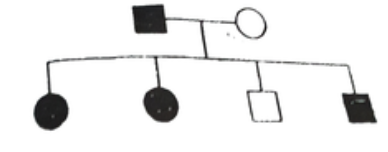Why is pedigree analysis done in study of human genetics ? State the conclusions that can be drawn from it.
Video Solution
Text Solution
Analysis of a trait in generations of a human family is called Pedigree Analysis. It is quite easy to identify soma forms of inheritance from the study of pedigrees. Thus consiferable information can be achieved from analysis of extensive pedigrees. from analysis of extensive pedigree. Since test Control crosses are not possible in case of human beings.
(i) conclusions, acn be drown from pedigree analysis of traits in several generation of family.
(ii) to trace the pattern of Inheritance wheter the trait is dominant or recessive.

|
Updated on:21/07/2023
Topper's Solved these Questions
- BOOK - XII BOARD PREVIOUS YEAR PAPER ENGLISHCHAPTER - XII BOARDSEXERCISE - SET - I SECTION D8videos
XII BOARDS
- BOOK - XII BOARD PREVIOUS YEAR PAPER ENGLISHCHAPTER - XII BOARDSEXERCISE - DELHI BOARD 20161videos
XII BOARDS
- BOOK - XII BOARD PREVIOUS YEAR PAPER ENGLISHCHAPTER - XII BOARDSEXERCISE - C.B.S.E. CLASS- XII99videos
XII BOARDS
- BOOK - XII BOARD PREVIOUS YEAR PAPER ENGLISHCHAPTER - SAMPLE PAPER 2019EXERCISE - Section E Part B3videos
SAMPLE PAPER 2019
Similar Questions
Knowledge Check
- Question 1 - Select One
Study the given pedigree chart of a certain family and select the correct conclusion which can be drawn for the character
 AThe female parent is heterozygousBThe parents could not have had a normal daughter for this characterCThe trait under study could not be colourblindnessDThe male parent is homozygous dominant
AThe female parent is heterozygousBThe parents could not have had a normal daughter for this characterCThe trait under study could not be colourblindnessDThe male parent is homozygous dominant - Question 2 - Select One
A conclusion drawn from the passage is that:
Afear of failure removes complacency in a person.Bfear of failure is necessary for one to value success.Cfailure is the growth factor as one learns from it and grows.Dthe loss of faith and hope is believed to arise from failure
State the condition for maximum current to be drawn from the cell.
View SolutionWhat is pedigree analysis? Suggest how such an analysis, can be useful.
View SolutionStudy the pedigree chart of a certain family given below and select the correct conclusion which can be drawn for the character
 View Solution
View SolutionSee the given figure below and answer the given questions?
What are the conclusions drawn from the experiment ?View SolutionThe circle to which two tangents can be drawn from origin is
View SolutionWhat is Pedigree analysis? Suggest how much analysis can be useful?
View Solution

